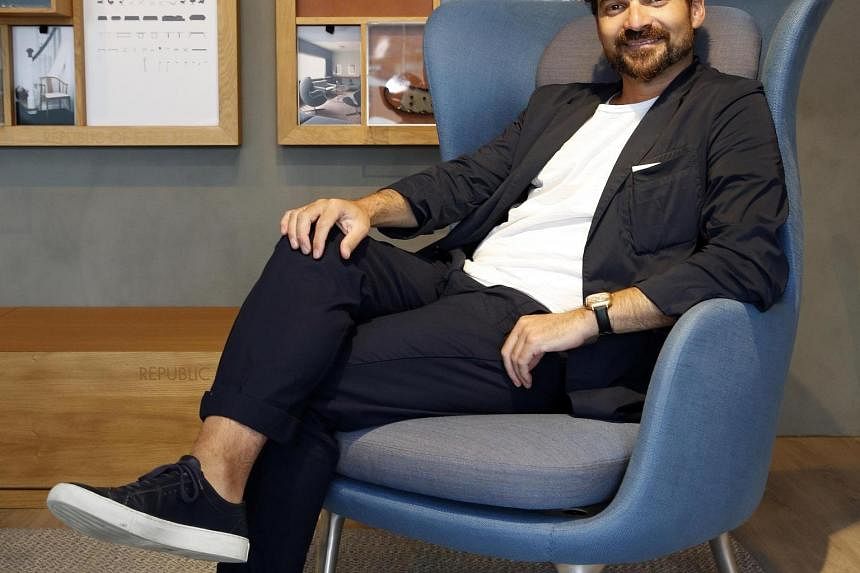Of all the exuberant pieces that Spanish designer Jaime Hayon created for the Salone del Mobile furniture fair in Milan two months ago, it was a simple chair that surprised many.
The Mila chair is a curvy beauty with its rounded backrest and arms, and comes with elegantly spindly legs - and it is made of plastic.
Plastic is not exactly fantastic for Hayon, who is using it to make a product for the first time.
As he is a champion of using natural materials - think wood, metal and ceramic - working with synthetics goes against his ethos.
"I always work with materials that are very noble," says Hayon, 41. "I like material that has belonged to the earth for a long time and it just evolved in a natural way. So this is quite surprising - I'm not a plastics boy."
For the Mila chair - a collaboration with Italian design brand Magis - he used Magis' gas-assisted injection- moulding technology, where high-pressured nitrogen is pumped into a mould.
During an interview last week in Singapore, Hayon says he took a chance with plastic as it would make the chair more "democratic for everyone", since plastic can be moulded easily and is cheaper.He initially wanted to make it in wood, but it has many joints.
Despite his resistance to plastic, he decided to try it out. "I love it when there's a challenge. And people love the chair because it's functional, uses a new technology and it's peculiar.
"But I don't think I will do any more plastic chairs."
While surprising, his plastic experiment with the Mila chair is typical Hayon. Never one to colour within the lines, the designer has built a reputation for being unpredictable - in a good way.
Big names - including Cassina, the revered Italian furniture house, and Fritz Hansen, the Danish furniture label which has partnered famous designers such as Arne Jacobsen - have hired him to dream up designs over the years.
Even an unlikely client, fine crystal glassware company Baccarat, clamoured for the whimsical Hayon touch.
In 2009, he created Crystal Candy, a range of nine crystalware inspired by fresh tropical fruit, for Baccarat.
To crystal purists, the colourful and oddly shaped pieces would have been a travesty.
But the limited-edition collection - 25 pieces of each design were made - was sold out, with the prototypes going for three times the price, says Hayon, the 2010 Maison & Objet Designer of the Year in Paris.
"Baccarat had never done anything like that before, creating vases which look more like sculptures, and combined glass and ceramics. It was afraid to mix materials and see it in a different context.
"For me, it all made sense when it all went 'wrong'. It's the unexpected that makes the success."
In a realm where many designers play it safe with clean lines and tried-and-tested shapes, the artist-designer is a breath of fresh air.
He has launched myriad designs, from nonsensical sculptures such as a landscape of ceramic cacti to the adorable yet functional collection of mushroom-shaped lamps for lighting label Metalarte.
Even if his brand of functional frivolity is in demand, Hayon is selective about the work he does, choosing to collaborate with companies who are "willing to break the rules".
"If I'm here just to make the next thing look like the one before it, then we're done. When I confront a company, all of them want something new all the time.
"With me, they are already conditioned to break the rules."
The Madrid-born Hayon has honed his skills for delivering new ideas through the years.
He studied industrial design in his hometown and, later, Paris.
In 1997, after graduating, he worked as a trainee at the Benetton Group's Fabrica studio in Treviso, Italy, under the tutelage of controversial Italian photographer Oliviero Toscani, who was creative director at Benetton.
A year later, Hayon was appointed head of the design department, where he stayed until 2003.
In between, he set up Hayon Studio in 2000 and became the talk of the town, in particular for his solo art installation, Mediterranean Digital Baroque, at London's David Gill Gallery in 2003.
This featured colourful graffiti-like images and incredible creations such as supersonic pigs with long snouts.
He went on to create installations at major galleries and museums, such as the Groninger Museum in the Netherlands, London's Design Museum and the Centre Pompidou in France.
Hayon, whose father was a jeweller and mother worked in the restaurant business, has also chalked up his fair share of accolades.
Wallpaper* magazine named him one of the most influential creators of the last decade, while Time magazine crowned him "one of the most creative icons and thinkers in their fields" for The Style & Design 100 edition in 2007.
Now based in Valencia, Hayon says he has made his mark, without pandering to popular trends or craving mass approval.
"I'm much more interested in the process of building something I dream about, rather than how it's going to be used. I don't think about people so much. I design how I like."
It is a process that he says speaks of the times: "Industrial design today is not like it was in the 1950s, where it was about serving the masses.
"Today, it's about function, but it's also about storytelling and soul in the work.
"So I think I'm more honest and less selfish for making something I love rather than something that follows a brief and kills the creativity."
Constantly dreaming and experimenting, the multilingual Hayon has a new source of inspiration: his children. He is married to Dutch artist Nienke Klunder, with whom he has collaborated many times. The couple have two sons aged four and two.
Hayon, who makes time in his hectic schedule for his children every day, says: "Their innocence is the most peculiar way to look at creativity.
"Adults are contaminated. Children are not and they're always taking risks. When adults try to innovate - how complicated is that?"
Without a hint of irony, he says: "You only innovate if you don't know what you're doing."
Even though he has been on a roll for a while now, Hayon has not run out of steam nor does he feel he has reached his peak yet.
"I must have done something right somewhere for these things to continue. I don't have time to celebrate the success - I just do what I like.
"I've realised that if I'm true to my creativity, there's no reason there should be a peak. I go naturally into it. I'm not forcing the machine."
A look at Jaime Hayon's works
Mila chair For Magis

Shown at the Salone del Mobile furniture fair in Milan in April, the Mila chair by Hayon is made of plastic, a material not usually used by the Spanish designer. The curvy design was created using Italian design label Magis' gas-assisted injection-moulding technology, where high-pressured nitrogen is pumped into a mould.
Reaction Poetique For Cassina

Paying homage to one of the world's best designers, Hayon created a set of furniture pieces in various shapes of Le Corbusier's architecture and artwork. The Swiss-French polymath, who was an architect, designer, painter and urban planner, among other roles, is a pioneer of modern architecture.
Hayon's work was shown at the recent industry furniture fair Salone del Mobile in Milan and commemorates the 50th death anniversary of
Le Corbusier. Looking like spaceships, these comprise four table centrepieces, a tray made up of two coffee-bean shapes and two side tables. The pieces are made with solid ash-wood stained black with a low-gloss finish.
In an interview about the design process, published on platforms such as Designboom, Hayon said: "It was a very strict, almost religious challenge to use only one material and one finish, exercising my design philosophy. I feel this restriction actually became an opportunity to showcase the beauty of the wood, along with the expert mastery of Cassina's carpentry workshop."
American Chateau By Jaime Hayon & Nienke Klunder

Hayon and his wife, photographer Nienke Klunder, teamed up to produce a series of works inspired by American opulence. Shown in London in 2009, this was the couple's first public collaborative exhibition.
One of the pieces in the collection is New York Is Miami,
a cabinet made from highly lacquered pine wood and bevelled glass. The serious-looking, grey skyscrapers - perched on top of drawers with baubled legs - that define Manhattan's skyline are given a fun twist, as Hayon colours them pastel pink, blue and yellow, much like the buildings in Miami.
Green Chicken

Hayon dreamt up this larger-than-life chicken rocker and painted it a shade of glossy green, complete with door-knob ears.
Writing on his website, Hayon says: "I wanted to portray this common bird as a sensational object... turning it into a modern piece, one of great beauty and utility: a rocking chair. My green chicken had taken on a face, a shape, a place and a function."
It was part of Funtastico, his first solo exhibition in 2013, at the Groninger Museum in the Netherlands. He had previously done the interiors of the museum's information centre in 2010.
The 1.2m-tall sculpture, which he made in 2012, is just one of many wacky, delightful designs that he has shown.
Other creations include a giant purple hot dog sculpture which one can ride on and an installation of life-size chess pieces to kick off the London Design Festival.
Urban Perspectives For Mini

Proving his versatility across genres, Hayon created new looks for two flexible electric kick-scooters for the car company. He also showcased them, along with a quirky installation, at this year's Milan Design Week.
Sleek and stylish, the two scooters are decked out in luxurious materials such as naturally coloured leather for the handlebars, copper detailing and stripey blue-on-white designs. But Hayon's involvement went beyond jazzing up staid versions of Mini's kick-scooters.
To express the idea of an urbanite zipping about town on these cool rides, he produced an exhibition featuring "lanes" on the floor, with dots and stripes running across the floor and walls.
A curvy 40m-long marble table, with a race track on its surfaces, weaves through striped columns. Hayon also thought about the look of the scooter's rider, creating accessories to complete the look. He designed a helmet and two jackets which have numerous pockets - a necessity for a gadget-heavy urbanite.
FAVN For Fritz Hansen

This sofa, with its soft curves, multiple fabric choices and bold colours, is the perfect marriage of Hayon's flamboyant designs and the Danish furniture design company's notable minimalism.
Favn is the Danish word for embrace, and much like his design predecessors who produced work for Fritz Hansen, Hayon took inspiration from the idea of a shell. Danish architect Arne Jacobsen played on this concept as well when he crafted the Egg Armchair and the Swan Armchair.
Hayon, in an interview published on design blog Design Milk, said: "I wanted the sofa to be based on a shell. A shell being hard on the outside, soft and welcoming on the inside."
Home owners can opt for Favn in nine colours. The $15,130 sofa is sold at W Atelier, which has a store in Bukit Timah Road.


